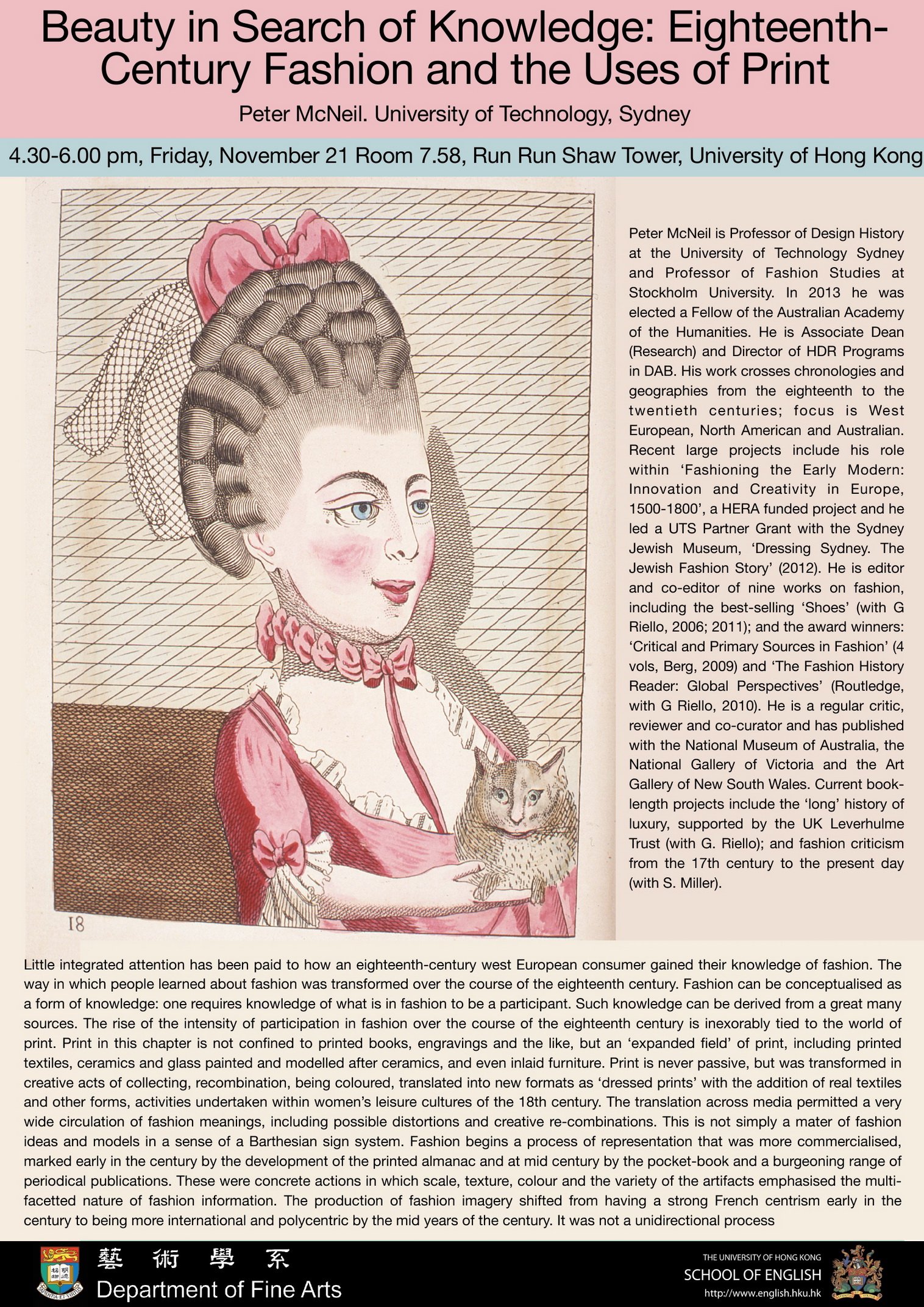

Beauty in Search of Knowledge: Eighteenth-Century Fashion and the Uses of Print
November 21, 2014 @ 4:30 pm - 6:00 pm
Beauty in Search of Knowledge: Eighteenth-Century Fashion and the Uses of Print
Date: 21 November 2014 (Friday)
Time: 4:30-6:00pm
Venue: Room 7.58, Run Run Shaw Tower, Centennial Campus
Little integrated attention has been paid to how an eighteenth-century west European consumer gained their knowledge of fashion. The way in which people learned about fashion was transformed over the course of the eighteenth century. Fashion can be conceptualised as a form of knowledge: one requires knowledge of what is in fashion to be a participant. Such knowledge can be derived from a great many sources. The rise of the intensity of participation in fashion over the course of the eighteenth century is inexorably tied to the world of print. Print is this chapter is not confined to printed books, engraving and the like, but an ‘expanded field’ of print, including printed textiles, ceramics and glass painted and modelled after ceramics, and even inlaid furniture. Print is never passive, but was transformed in creative acts of collecting, recombination, being coloured, translated into new formats as ‘dressed prints’ with the addition of real textiles and other forms, activities undertaken within women’s leisure cultures of the 18th century. The translation across media permitted a very wide circulation of fashion meanings, including possible distortions and creative re-combinations. This is not simply a matter of fashion ideas and models in a sense of a Barthesian sign system. Fashion begins a process of representation that was more commercialised, marked early in the century by the development of the printed almanac and at mid-century by the pocket-book and a burgeoning range of periodical publications. These were concrete actions in which scale, texture, colour and the variety of the artifacts emphasised the multi-facetted nature of fashion information. The production of fashion imagery shifted from having a strong French centrism early in the century to being more international and polycentric by the mid years of the century. It was not a unidirectional process.
Speaker: Peter McNeil
Peter McNeil is Professor of Design History at the University of Technology Sydney and Professor of Fashion Studies at Stockholm University. In 2013 he was elected a Fellow of the Australian Academy of the Humanities. He is Associate Dean (Research) and Director of HDR Programs in DAB. His work crosses chronologies and geographies from the eighteenth to the twentieth centuries; focus is West European, North American and Australian. Recent large projects include his role within ‘Fashioning the Early Modern: Innovation and Creativity in Europe, 1500-1800’, a HERA funded project and he led a UTS Partner Grant with the Sydney Jewish Museum, ‘Dressing Sydney. The Jewish Fashion Story’ (2012). He is editor and co-editor of nine works on fashion, including the best-selling Shoes (with G Riello, 2006; 2011); and the award winners: Critical and Primary Sources in Fashion (4 vols, Berg, 2009) and The Fashion History Reader: Global Perspectives (Routledge, with G Riello, 2010), He is a regular critic, reviewer and co-curator and has published with the National Gallery of Victoria and the Art Gallery of New South Wales. Current book-length projects include the ‘long’ history of luxury, supported by the UK Leverhulme Trust (with G. Riello); and fashion criticism from the 17th century to the present day (with S. Miller).



Find us on…